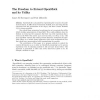Free Online Productivity Tools
i2Speak
i2Symbol
i2OCR
iTex2Img
iWeb2Print
iWeb2Shot
i2Type
iPdf2Split
iPdf2Merge
i2Bopomofo
i2Arabic
i2Style
i2Image
i2PDF
iLatex2Rtf
Sci2ools
MICS
2008
2008
The Freedom to Extend OpenMath and its Utility
Abstract. OpenMath [6] is a standard for representing the semantics of mathematical objects. It differs from Presentation MathML [8] in not being directly concerned with the presentation of the object, and from Content MathML 2 [8] in being extensible. How should these extensions be performed so as to maximise the utility (which includes presentation) of OpenMath? How could publishers have the freedom to extend and let consumers find their way with expressions discovered on the Web? The answer up to now has been, too often, to say "this is not specified" whereas the existing content dictionary mechanism of OpenMath allows it to include formal properties which state mathematical facts that should stay uncontradicted while manipulating the symbols. The contribution of this paper is to propose methods to exploit the content dictionaries so as to allow an OpenMath-consuming tool to process expressions even if containing symbols it did not know about before. This approach is gener...
| Added | 13 Dec 2010 |
| Updated | 13 Dec 2010 |
| Type | Journal |
| Year | 2008 |
| Where | MICS |
| Authors | James H. Davenport, Paul Libbrecht |
Comments (0)

